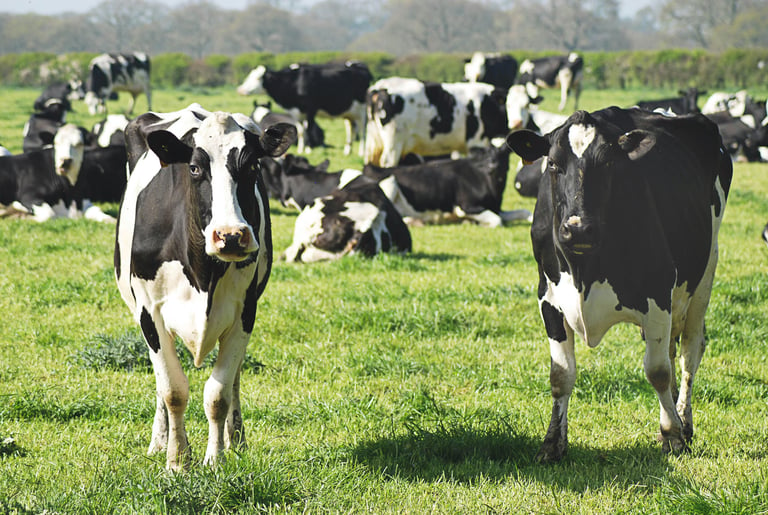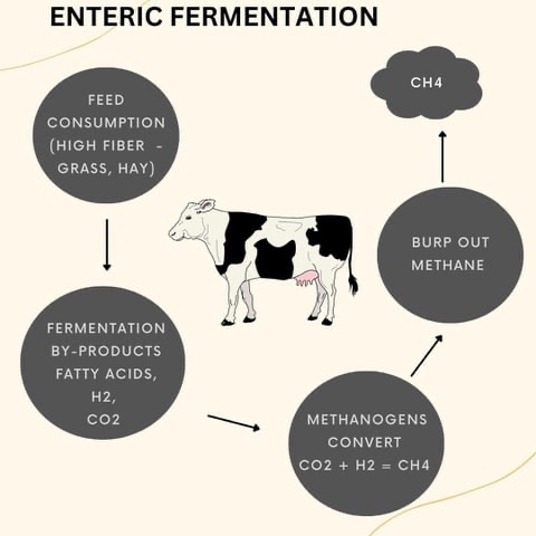How significant is the Cattle Burping Problem?
Last week, while surfing through the MIT Technology Review: 10 Breakthrough Technologies of 2025 list, it wasn’t surprising to see the inclusion of Generative AI, Robotaxis, and SAF. As I kept reading, I came across a technology aiming to solve one of the trickiest climate change problems. It wasn’t some new Carbon Capture Technology or Sustainable Materials; it was "Cattle Burping Remedy Medication." Seemingly simple, yet profoundly impactful, it addresses cattle burping, which is a real climate issue. It is estimated that the Methane gas (28x CO2 eq. – 100 yrs.) that cattle belch out as a by-product of digestion, contributes 12% to the world’s total GHG emissions! That is more than the GHG emissions of the aviation industry! In this week’s article on sustainability, we explore how significant the Cattle Burping problem is and how researchers are deploying modern biochemical and dietary remedies to mitigate the environmental impact.
AGRICULTURE AND ENERGYMOST RECENTSUSTAINABLE TECHNOLOGIES
Sumedh Joshi
10/17/20254 min read


Methane, a greenhouse gas accounts for a third of global warming. While it is short lived in the atmosphere (Average life – 12 years), it is 28x more potent in terms of global warming potential than CO2. Human activities like farming, livestock management, fossil fuel exploration, and transportation, account for 60% of global methane emissions. Out of this 60%, 50% of Methane emissions can be attributed to livestock management.


A refresher on the basic elementary school biology curriculum: cows, deer, sheep, and buffalo belong to a group of animals called ruminants. Ruminants are capable of ingesting a large amount of hay and grass and later digest it by regurgitating and rechewing. In the cattle’s stomach, rumen, a microbe that is a methanogen, converts the excess hydrogen and CO2 during this process to methane. This is enteric methane that is expelled from the cattle’s body as burping or belching.
Putting the total Enteric Methane Emissions into a Global Context
Several articles estimate that total methane production from livestock is 120 million tonnes/year (2021). With a Global Warming Potential for Methane (100 years) being 28x CO2 Equivalent, total equivalent CO2 emissions from cattle burping are 3 billion tonnes per year. This is the top-down approach. The bottom-up approach estimates that Methane released per cow per year is around 70-120 kg. Total CO2 equivalent/cow/year is 2 tonnes. As of 2023, the global cattle population is estimated to be 1.5 billion. This gives us a total CO2 equivalent from enteric methane emissions of 3 billion tonnes/year.
3 billion tonnes CO2 eq./year is equivalent to –


This shows us how significant this challenge is. Let us now see how researchers around the globe are racing towards finding the most effective and cost-efficient remedy.
Remedies for Cow Burping
Several researchers have developed techniques that revolve around diet modifications. These are explained below.
1. Changing Cattle Diet
Feeding cattle with an increased percentage of high-quality forage, like legumes, makes digestion easy. Legumes are a good source of highly soluble carbohydrates, which produce less methane. Maize and soy are other effective alternatives. Unsaturated fats are also a high-energy source and can thwart enteric methane production.
2. Feed Additives
The MIT article talked about feed additives like Rumen Modifiers, which modify the rumen bacterial environment in the stomach to lower methane production by 30% and Direct Inhibitors like [3-NOP] (3-nitrooxypropanol), halogen-containing seaweed, or synthetic boroform, that inhibit the enzymes of ruminal methanogenesis and reduce methane production by 30-95%.
3. Cow Masks
Cow masks are masks specifically designed for cows that detect, capture, and oxide methane released from the nostrils and mouth of the cow. The catalyst in the mask breaks down methane into CO2 and water. These can reduce the enteric methane production by 60%
4. Vaccines
Vaccines target methanogens in the cattle’s digestive system. Many startups are entering the market with various vaccines in R&D phases to help suppress methanogens.
5. Genetic Selection
Genetic Selection, like microbiome-based breeding strategies, metagenomic investigations, and genetic selection of animals, are some methods that will allow cattle breeds to have low enteric emissions.
Future Outlook
The cattle burping climate challenge remains one of the most complex challenges out there due to a variety of stakeholders involved. Farmers and cattle owners are often reluctant to address the enteric burping issue due to lower incentives and a lack of generic remedies available in the market. Again, the effects of deploying these remedies on the quality and properties of milk are sparsely studied. The most common impediment is the limited awareness about this problem in rural areas, where farming and cattle are a prime source of income. To address this, governments should provide incentives and training to find ways for cattle owners to take steps towards mitigating this issue. For example, the US Senate has introduced the Enteric Methane Innovation Tools for Lower Emissions and Sustainable Stock (EMITLESS) Act, which aims to provide farm owners with the tools and resources needed to bolster the research into finding new solutions to ensure safety and productivity for cattle. Another innovative incentive program started by Bovaer, a carbon credit seller, lets farmers who use some of the pre-approved enteric methane emission remedies earn greenhouse-gas credits and sell them to organizations looking to reduce their carbon emissions. This ensures that farmers are incentivized while attracting corporate funds into buying good-quality carbon credits. While research and development continue, there is a strong need to spread awareness amongst people who are unaware of this problem and incentivize them to take appropriate measures.
References
https://earth.org/cow-burps-and-global-warming-whats-the-link/
Environmental Protection Agency (EPA). (2023). Greenhouse gas emissions from a typical passenger vehicle. United States Environmental Protection Agency. https://www.epa.gov/greenvehicles/greenhouse-gas-emissions-typical-passenger-vehicle
Food and Agriculture Organization of the United Nations (FAO). (2021). Tackling climate change through livestock: A global assessment of emissions and mitigation opportunities. FAO. https://www.fao.org/3/i3437e/i3437e.pdf
Global Carbon Project. (2023). Global Carbon Budget 2023. Earth System Science Data, 15(11), 5301–5369. https://doi.org/10.5194/essd-15-5301-2023
International Energy Agency (IEA). (2022). Tracking aviation 2022. IEA. https://www.iea.org/reports/tracking-aviation-2022
International Energy Agency (IEA). (2023). World energy outlook 2023. IEA. https://www.iea.org/reports/world-energy-outlook-2023
International Energy Agency (IEA). (2023). Electricity information 2023. IEA. https://www.iea.org/reports/electricity-information-2023
Intergovernmental Panel on Climate Change (IPCC). (2022). Climate Change 2022: Mitigation of Climate Change (AR6 Working Group III Report). Cambridge University Press. https://www.ipcc.ch/report/ar6-wg3
Our World in Data. (2023). Cattle livestock count (heads). Our World in Data. https://ourworldindata.org/grapher/cattle-livestock-count-heads
Connect
info@energizetomorrowus.com
© 2025. All rights reserved.


